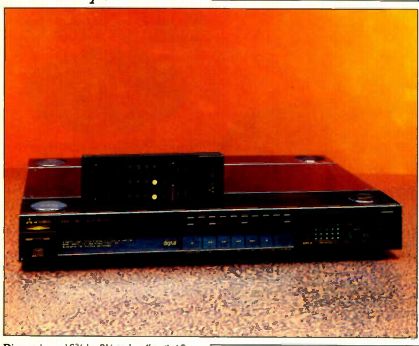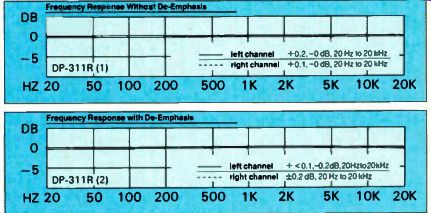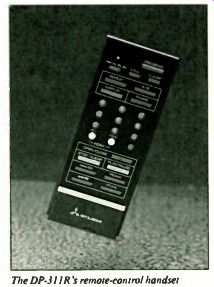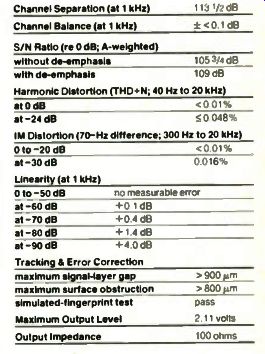
Dimensions: 16 3 / 4 by 2 1/4 inches (front), 13 inches deep plus clearance
for connections. Price: $740. Warranty: Limited, two years parts, one
year labor. Manufacturer: Mitsubishi Electric Corp., Japan.
U.S. Distributor: Mitsubishi Electric Sales America, Inc., 5757 Plaza Dr., Cypress, Calif.
Chip and CD mech: 2xPCM56P; MLP-4
Mitsubishi has not been the most visible name in audio during its years in the U.S. market, but the company has been responsible for some startlingly original models. One of these, the DP-311R CD player, features a striking design that sets it apart in a world of lookalikes. It contains some of the company's most advanced technology: namely, the single Photo-Direct convert the laser-beam pulses into electrical signals and an amplifier to strengthen those signals immediately.
A glance at the widely spaced output jacks on the back panel makes it evident that Mitsubishi (like a number of other companies, at least in their premium products) is taking care to keep signals pristine by adopting a "dual-mono" approach. That is, each channel is given its own circuit elements to minimize crosstalk. Another visible indication of extra care is the unit's hefty structure (given its slim profile) and vibration-isolation feet.
Avoidance of mechanical resonances that can encourage mistracking is attracting increasing attention for premium designs, and the 311 is indeed exceptionally impervious to external shock.
Even more interesting are the controls. All the usual functions--play, pause, stop, and fast-scan and seek (skip) in both directions, as well as the disc drawer control--are activated by large slanted buttons near the lower center of the front panel. Above them are small buttons for programming and repeat and for polarity (absolute phase) of the output--an extremely rare feature. Atop this center section is the numerical keypad.
To the right are the displays. First is a panel that shows whether repeat is on and whether start and stop points have been programmed for repeat of a hand picked portion of the disc (A-B repeat). The next panel shows, calendar style, which tracks (up to 20) are available on are included in your program. Then comes a display for time, track, and index number--with this last display convening to a selection number indicator during programming.
At the extreme right are pilots for various functions (including phase inversion) and a display switch. The latter steps from elapsed time in the current track (the default mode) to time remaining on the disc or programmed sequence, to ... nothing! That's right, you can shut off the display altogether (once the programming chores are complete) and revel in the dark gleam of the panel, uncluttered by glowing numbers. All that remains lit in the display area are the pilots--including one to show that the display-off mode has been chosen. Elegant.
The supplied wireless remote repeats all of these controls--even that for the drawer-and adds seek (by index as well as track number) and a button (CALL) that steps through the programmed selection numbers so that you can double check the sequence. The only control it doesn't repeat is the on/off power The DP-311R's remote-control handset switch, which is located at the left end of the front panel.



All of the performance measurements are excellent and have not been significantly bettered by any competitor, even in this hair-splitting field. Frequency response is very flat, with no appreciable rolloff even at the very top end of the spectrum. From this--and the symmetrical (and very well controlled) ringing in the square-wave and pulse traces--it is clear that digital filtering is employed.
Moreover, our listeners professed to hear subtle virtues in the DP-311R above and beyond the routine call of dig ital perfection. Clarity, transparency, and warmth seem in slightly more abundant supply than usual. This may be due in pan to our fascination with the absolute-phase switch, which seems to make an appreciable difference with some recordings and consequently adds piquancy to the listening process.
Some recording setups (and recordings, for that matter) invert polarity so that transients begin with an acoustic rarefaction rather than with the normal pressure front. Some playback electronics reverse it as well, which for once makes a right out of two wrongs--but not of three, which will again leave you with inverted phase. Even when a difference is clearly audible, however, it's not necessarily clear which option is the "correct" one, unless you've done some preparatory homework. We suspect most home listeners will find investigating the difference interesting at first and finally settle on a standard position for most recordings. You can always investigate the options more thoroughly and make a note of those discs you prefer to play "upside down" from the rest.
Clearly, we are impressed with the DP-311R. Beneath its handsome exterior lies a reproducer of unusual excellence. Well done, Mitsubishi.
--------
From Stereo Review, Feb. 1988
Mitsubishi DP-311R -- Features:
Die-cast chassis with internal bracing to minimize transmission of vibration, top cover stiffened with plastic panels
Vibration-isolating mounting feet
Quadruple-oversampling digital filtering
Programming for up to thirty-six tracks in any order
Keypad for programming and direct access to any track
Direct access to any indexed portion of a disc with remote control.
Track skipping and fast search, with audible sound, in either direction.
Repeat of single track, entire disc, programmed sequence, or any selected portion of disc
Display of current track and index numbers and elapsed time in track or remaining time on disc and track position in programmed sequence
Switch to turn off display to minimize noise
Music Calendar to show numbers of unplayed tracks on disc or in program (up to twenty)
PHASE button to reverse phase of one channel, brings channels into phase on incorrectly mastered discs
LABORATORY MEASUREMENTS:
Maximum output level: 2.08 volts
Total harmonic distortion at 1,000 Hz: 0.006% referred to 0 dB, 0.002% referred to -10 dB, 0.012% referred to -20 dB
Signal-to-noise ratio (A -weighted): 106 dB
Channel separation: 110 dB at 1,000 Hz, 83 dB at 20,000 Hz
Frequency response: +0.05, -0 dB from 20 to 20,000 Hz
Dynamic range: 96 dB
Maximum phase shift (from 100 to 20,000 Hz): 4 degrees at 100 Hz
Cueing time: 1 second
Cueing accuracy: A
Impact resistance: top, A (B+ over disc); sides, A
Defect tracking: tracked maximum defect levels on Philips TS5A test disc
--------
Also see: